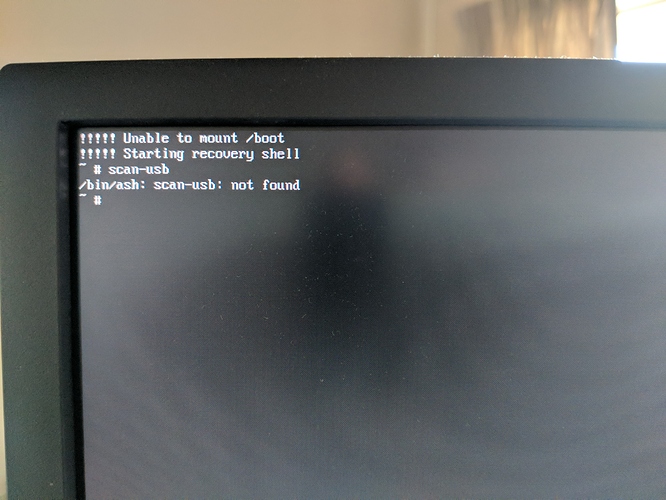I hope someone knowledgeable replies to you already.
FYI MBR stands for Master Boot Record, and the bootloader does need to go somewhere unencrypted, so I think (been a while since I messed with Debian installer. Not a fan) you should put the bootloader in the MBR.
Can you mount the USB drive from the recovery shell?
Perhaps, but not sure, consideration of “Reverting to the non-PureBoot, coreboot BIOS” should be involved when rethinking (erasing settings) how to solve current issue.
@kabo needs (just opinion) to find his way to where he was before (using functional PureBoot):
My thought was if @kabo can mount the USB from the recovery shell they can then specify it as the boot device.
Yes, I know (sorry for that)! I hope that @kabo will be back to you soon. Thank you for offering your help to him!
Are you saying that when you first turn the machine on, it doesn’t show the main menu (“Default Boot” / “Refresh TOTP/HOTP” / “Options” / “Power Off”), but requires you to select a /boot partition first?
If that’s the case, that seems dangerous and far too easy for people to lock themselves out!
If that is what happened, then what I would do is this:
-
Select menu options at random until it gives up and exits to a recovery shell.
-
Run the command “busybox mke2fs /dev/nvme0n1p1”. This will create a new empty filesystem on that partition, erasing anything that was there before.
-
Reboot and select /dev/nvme0n1p1 as your boot partition. You won’t be able to boot from it, but hopefully this should be enough to let you get to the main menu where you can select “Options” → “Boot Options” → “USB Boot”.
yes: run scan-usb from the recovery shell
this only happens when 1) the default /boot drive isn’t valid, and 2) auto-detection fails
I don’t think that’s necessary at all
Not sure what you mean by auto-detection. But what does it do if there are no partitions that it is capable of mounting? It sounds like that is @kabo’s situation (they have one encrypted partition and one swap partition, and nothing else.)
I literally mean the auto-detect function that I wrote that is part of Heads ![]()
the function first checks the default partition (/dev/nvmen0p1, unless chnaged/saved), then iterates through all fixed devices/partitions and checks for /grub*. If a partition fails to mount or is encrypted, it’s skipped. If no partition with grub is found, you get the prompt to manually select.
Makes sense. So then what happens after that? From what @kabo said, it sounds like if you don’t have any options available to select, or you select an “invalid” option, then it bails to a shell rather than showing the menu that would allow you to boot from USB.
In the upcoming B13 update, will alert you that no bootable disk was found, and ask if you want to proceed to main menu or boot from USB. In current release, it should allow you to cancel and pass to main menu but seems that isn’t happening
Good morning!
Correct, I’m not getting the main menu at all.
Tried running scan-usb
EDIT: Running mke2fs /dev/nvme0n1p1 in the recovery shell allowed me to access the normal menu, thanks!
der, it’s usb-scan
Looks like Calamares (the installer used when installing debian from the live image) doesn’t support the disk setup I want (multiple LVM volumes under a single LUKS container).
I’ll just wait for PureBoot version 13 and hope that I can boot the normal debian installer with that.
I’m having the exact same issue, I want to have a customized install using Debian 10.4 but have had some issues with getting things to boot.
I think it comes down to this issue from upstream (https://github.com/osresearch/heads/issues/699), that some of the debian images don’t have the Intel i965 drivers. I’m also trying to install it custom with an LVM, so this is what I’ve found with the ISOs thus far:
- debian-10.4.0-amd64-netinst.iso - does not boot (no i965 drivers?)
- debian-live-10.4.0-amd64-gnome.iso - has all the drivers, but can’t customize the install
- debian-10.4.0-amd64-DVD-1.iso - does not boot (no i965 drivers?)
- debian-live-10.4.0-amd64-standard+nonfree.iso - has necessary drivers and boots, but might be using non-free drivers/firmware
- debian-live-10.4.0-amd64-standard.iso - boots with correct i965 drivers (not sure about ath9k drivers yet)
Both of the standard ones work, though the one that doesn’t include non-free drivers is best. However they both just boot to a live shell, not sure how to launch the installer from there?
I checked in the #debian-live IRC channel, they said that there was no way to launch the normal installer once booted into the live shell.
If you can manage to boot into Debian live, couldn’t you then use debootstrap (or cdebootstrap) to install Debian with whatever custom setup you want?
I’m sure anything is possible once one is booted into debian live. I just don’t know how to do that, nor have the time to figure it out.
It could also be that I just chose the wrong boot option from the drive, will test that out some more later.
EDIT: I think I’m just having a really hard time reading the boot entries from the PureBoot menu, I think this is the correct boot option.
menuentry "Debian Installer" {
linux /d-i/vmlinuz "${loopback}"
initrd /d-i/initrd.gz
}
I could also edit the grub.cfg on the ISO to make it easier to choose the right boot option.
Also I looked up how to install from debootstrap, it actually doesn’t look too hard. The tricky part would be just doing your partitions and creating an LVM manually, but there’s tons of documentation out there for that. Thanks for the tip @mat8913!
After flashing the mini with purism’s coreboot/seabios (no heads) I can start the normal debian installer. Once I’m satisfied that I don’t need to reinstall the OS I can flash pureboot again.
